To mix patterns without regret, start with a cohesive color palette to unify different designs. Balance large and small patterns, and layer textures to add depth without clutter. Keep contrast intentional by pairing bold prints with subtle ones, and use accessories to tie everything together. Focus on placement and proportion to create harmony. When you integrate these tips, you’ll craft confident, stylish combinations that feel just right—more helpful insights await to perfect your pattern game.
Key Takeaways
- Stick to a cohesive color palette to unify diverse patterns and prevent visual clash.
- Balance large and small patterns to create harmony and avoid overwhelming the space.
- Incorporate texture contrast thoughtfully, pairing smooth fabrics with textured ones for depth.
- Use pattern repetition and placement strategically to guide the eye and maintain visual flow.
- Limit bold patterns and accessories, focusing on subtle, complementary designs for a confident, stylish look.
Understanding the Basics of Pattern Mixing
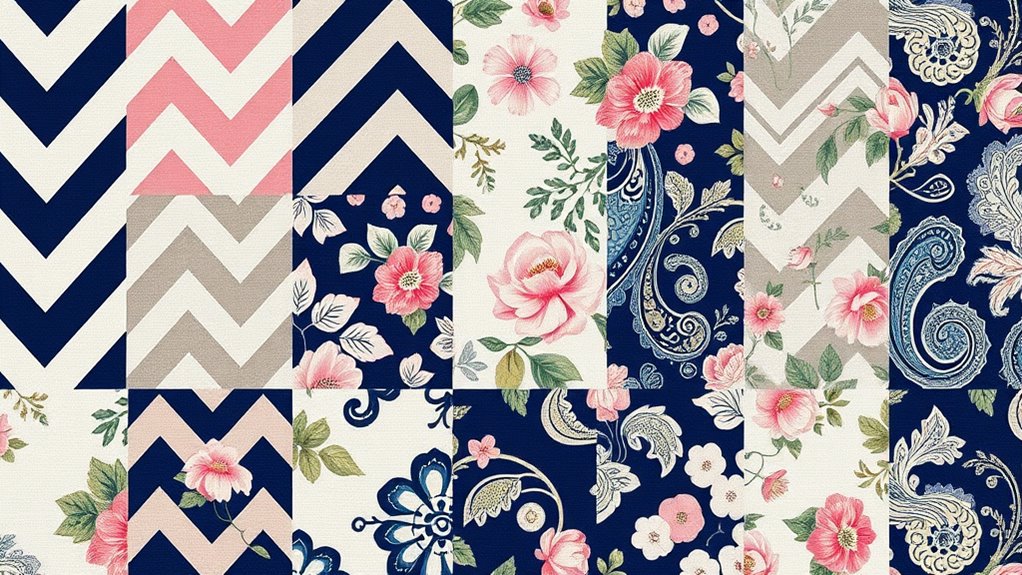
Pattern mixing involves combining different designs in your outfit to create visual interest and express your personal style. To master this, focus on pattern repetition; repeating a pattern element, like stripes or florals, ties different pieces together, creating harmony. Texture contrast also plays a key role—pairing smooth fabrics with textured ones adds depth and keeps your look dynamic. Start with a common color palette to unify your patterns and avoid clashing. Mixing large and small patterns can add variety without overwhelming the eye. Remember, balance is essential: if one pattern is bold, keep the others more subdued. By paying attention to pattern repetition and texture contrast, you’ll craft cohesive outfits that showcase your style confidently. Incorporating visual interest in textiles, such as different fabric textures or finishes, further enhances your overall look.
Choosing a Color Palette for Balance
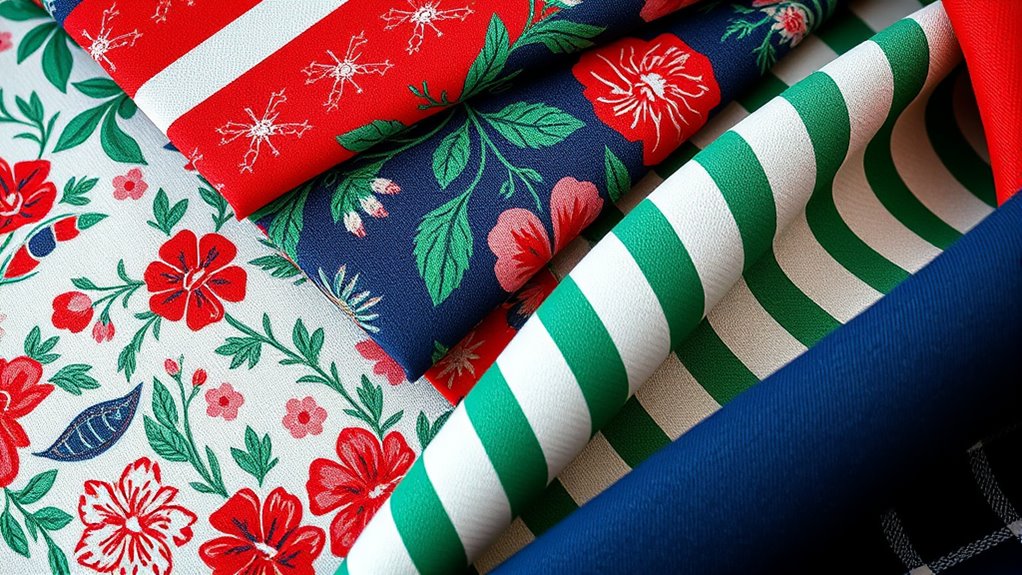
Selecting the right color palette is essential for creating a balanced and cohesive look when mixing patterns. Monochrome schemes are a safe choice, using varying shades of a single color to unify different patterns without overwhelming the eye. They add depth and sophistication while maintaining harmony. Alternatively, complementary palettes—colors opposite each other on the color wheel—bring vibrancy and contrast, making patterns pop while still feeling balanced. When choosing, consider the mood you want to evoke; soft neutrals create calmness, while bold combinations add energy. Limit your palette to two or three main hues to prevent chaos. By carefully selecting a harmonious color scheme, you ensure your pattern mix feels intentional, stylish, and balanced without regret. Incorporating anime-inspired color schemes can also add a unique touch to your outfit, blending creativity with balance.
Mixing Scale and Proportion Seamlessly
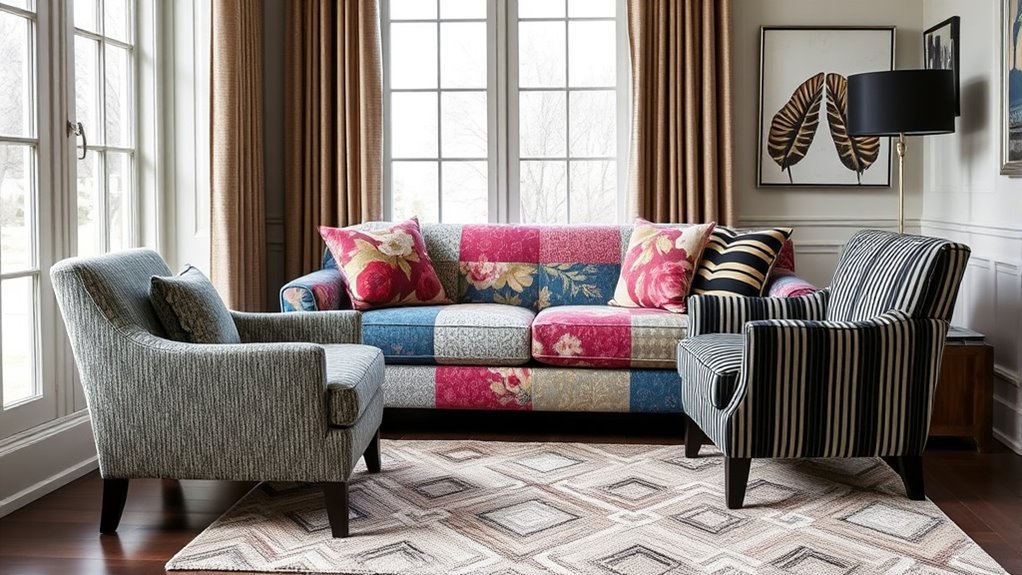
To create a cohesive look, you need to balance large and small patterns effectively. Varying height and width helps your space feel dynamic without overwhelming. By harmonizing visual weight, you make sure each pattern contributes seamlessly to your overall design. Additionally, understanding how to shift gears smoothly can help you maintain momentum and control, much like achieving a balanced pattern mix in your decor.
Balancing Big and Small
Balancing big and small elements in your design can create a dynamic and harmonious look that captures attention without overwhelming the viewer. To achieve this, consider how pattern repetition and visual rhythm guide the eye smoothly across the space. Mixing large-scale patterns with small ones adds interest and avoids monotony. Use bold, oversized motifs sparingly to anchor the design, then complement them with subtle, detailed patterns. This contrast emphasizes each pattern’s unique qualities while maintaining cohesion. Incorporating layered textures and colors can further enhance the inviting atmosphere and depth of your space. Here’s a visual idea:
| Big Pattern | Medium Pattern | Small Pattern |
|---|---|---|
| Oversized florals | Geometric shapes | Tiny polka dots |
| Large stripes | Medium-scale chevron | Fine herringbone |
| Bold motifs | Repeating motifs | Delicate lace |
| Statement wallpaper | Coordinating upholstery | Subtle accents |
| Dramatic murals | Smaller decorative elements | Intricate details |
Varying Height and Width
Varying height and width in your design creates a dynamic visual rhythm that keeps the eye engaged. By mixing different fabric textures, you add depth and tactile interest, preventing your space from feeling flat. Pay attention to pattern orientation—horizontal, vertical, or diagonal—to create contrast and movement. Combining tall, narrow patterns with broad, sweeping ones guides the eye smoothly across the room, establishing a sense of flow. Keep scale in mind: larger patterns can anchor a space, while smaller ones add detail. Introducing variety in height and width guarantees no element dominates, fostering a balanced, cohesive look. This deliberate mix keeps your design lively, engaging, and visually interesting without overwhelming the senses. Regularly assessing and rotating items can also help maintain this organized environment, preventing clutter from detracting from your design aesthetic.
Harmonizing Visual Weight
Harmonizing visual weight involves carefully mixing different scales and proportions to create a balanced, cohesive look. To achieve this, consider how pattern repetition guides your visual flow, ensuring no single element overwhelms the space. Keep in mind that:
- Varying scale helps distribute visual weight evenly across patterns.
- Repetition creates rhythm, making your design feel unified.
- Balancing large and small patterns enhances overall harmony.
- Incorporating essential oils with different effects can subtly influence the mood and perception of the space, adding another layer of harmony to your design.
Combining Patterns With Contrasting Textures
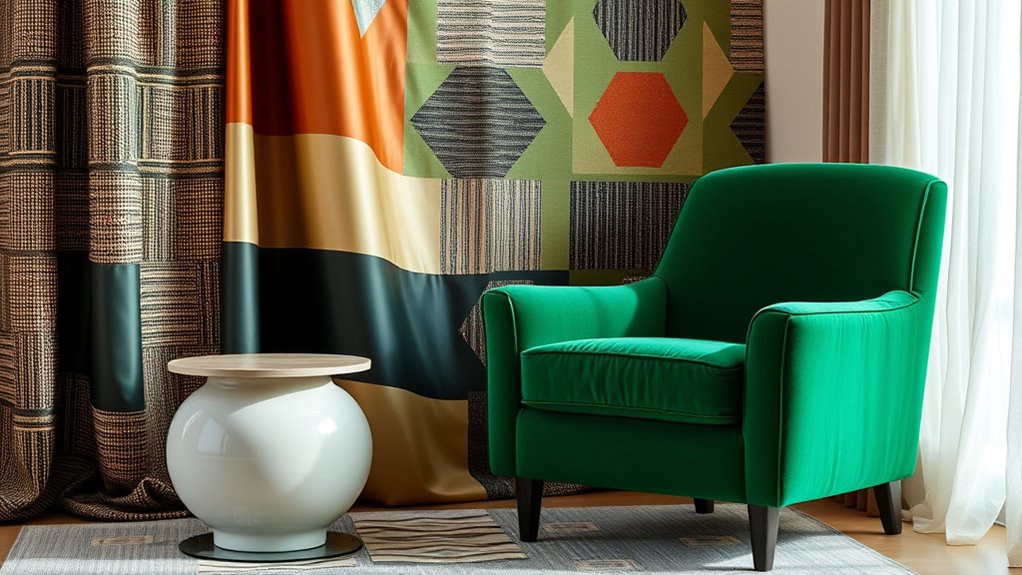
When combining patterns with contrasting textures, you want to create a balanced look that doesn’t feel chaotic. Focus on maintaining color harmony so the different textures work together seamlessly. By doing this, you’ll achieve a stylish and cohesive space that highlights both contrast and unity. Incorporating fabric decorating markers can also help personalize and unify your design elements for a more polished appearance.
Balance Contrasts Effectively
To create a balanced and visually appealing look, pairing patterns with contrasting textures can be highly effective. To avoid overwhelming your space, focus on contrast moderation, ensuring the textures complement rather than compete. Use pattern repetition to establish cohesion, tying different textures together seamlessly. For example, combine a smooth silk pillow with a textured woven throw, balancing shine and roughness. Keep these tips in mind:
- Limit the number of contrasting textures to prevent visual clutter.
- Use pattern repetition to unify diverse textures and patterns.
- Opt for subtle contrast moderation to maintain harmony without sacrificing interest.
- Incorporating an understanding of design principles can help you achieve a well-balanced aesthetic.
Focus on Color Harmony
Combining patterns with contrasting textures becomes more visually appealing when you focus on color harmony. Color contrast helps create visual interest without overwhelming the space, especially when you use a cohesive color palette. Monochromatic schemes are a great way to achieve this, as they use different shades and tints of a single color, maintaining harmony while highlighting texture differences. When mixing patterns, stick to a consistent color scheme to tie the look together. This approach allows you to experiment with contrasting textures and bold patterns without clashing. Pay attention to how colors interact and balance each other, ensuring the overall look feels intentional and unified. Additionally, understanding color coordination can help you select patterns that complement each other seamlessly. By focusing on color harmony, you can create a dynamic, stylish space that feels cohesive and thoughtfully curated.
Accessorizing to Enhance Your Pattern Mix
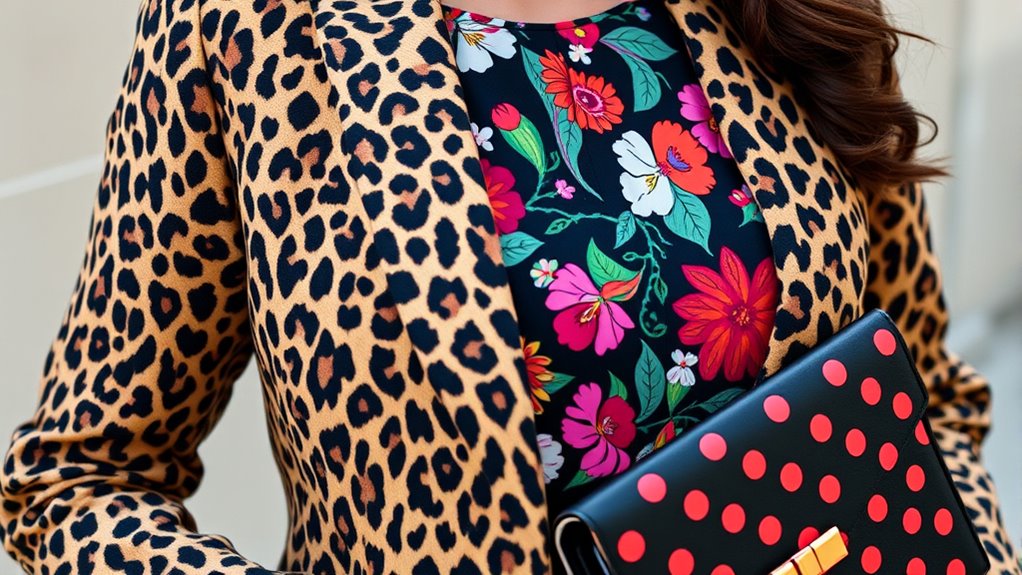
Accessorizing can profoundly elevate your pattern mix, drawing attention to your unique style and creating a cohesive look. Statement accessories are perfect for adding bold flair without overwhelming your outfit. Jewelry layering, in particular, allows you to combine delicate necklaces, chunky chokers, or stacking rings for visual interest. To enhance your pattern mix effectively, consider these tips:
- Choose statement accessories that complement your colors and patterns.
- Mix different textures and metals for a layered, curated feel.
- Keep other accessories simple to avoid clashing and maintain balance.
- Remember to respect user privacy by managing your cookie preferences, ensuring a personalized browsing experience.
Tips for Putting It All Together With Confidence
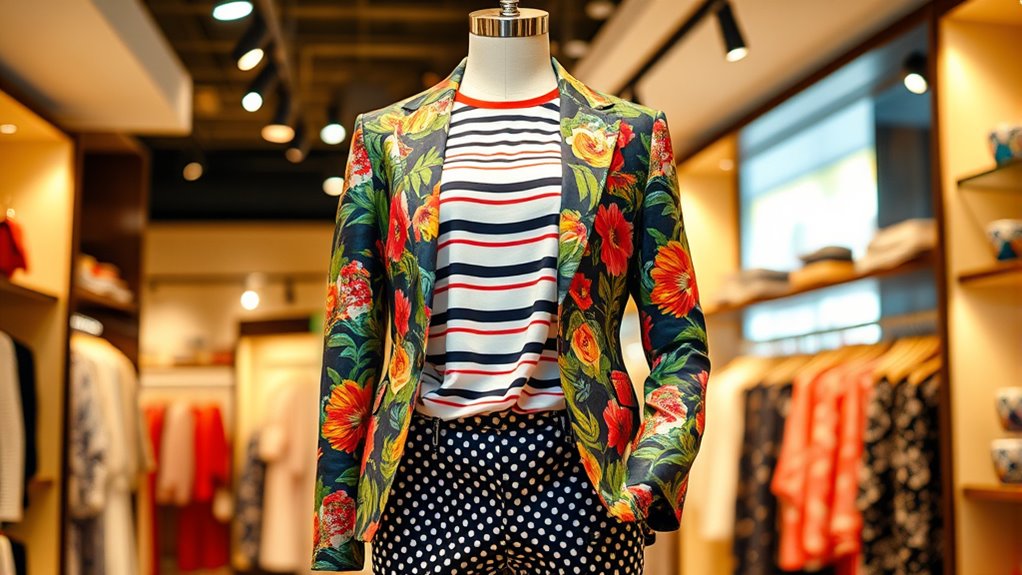
Pulling your pattern mix together with confidence starts with knowing when to keep things simple and when to make bold statements. Focus on pattern placement to create harmony; for example, pair larger prints with smaller, subtle patterns to avoid visual overload. Fabric selection also plays a vital role—smooth, matte fabrics tend to work well together, while mixing shiny or textured fabrics can add interest if balanced carefully. Stick to a cohesive color palette to unify your look, even with contrasting patterns. When in doubt, start with one statement piece and build around it, using simpler patterns or solid colors to ground your outfit. Confidence comes from intentional choices, so trust your instincts and enjoy experimenting with pattern placement and fabric selection.
Frequently Asked Questions
How Do I Avoid Clashing Patterns in My Outfit?
When you’re trying to avoid clashing patterns in your outfit, focus on pattern pairing and color coordination. Choose one dominant pattern and complement it with a subtle, coordinating print. Stick to a cohesive color palette to make certain the patterns work well together. Keep the rest of your outfit simple, and avoid mixing too many bold prints. This approach helps you create a balanced, stylish look without feeling overwhelmed.
Can Mixing Patterns Work for Formal Occasions?
Did you know that 65% of fashionistas believe pattern mixing can elevate formal looks? Yes, mixing patterns can work for formal occasions if you use the right pattern mixing techniques. Opt for subtle, complementary pattern combinations, like pinstripes with florals or checks with solids. Keep the color palette cohesive, and balance bold patterns with more subdued ones. With careful coordination, you’ll look stylish and sophisticated, even in formal settings.
What Are Common Mistakes to Avoid When Pattern Mixing?
When pattern mixing, you should avoid clashing patterns by paying attention to pattern scale and color coordination. Don’t mix large and small patterns that compete visually; instead, balance them for harmony. Also, steer clear of using too many bold colors together, which can overwhelm. Keep the focus on coordinating hues and varying pattern sizes to create a stylish, cohesive look without regret.
How Do Patterns Influence the Perceived Style or Personality?
Did you know 65% of people believe pattern choices reveal personality traits? Patterns greatly influence perceived style and personality expression. They act as visual cues, showcasing your creativity, confidence, or playfulness. By understanding pattern psychology, you can intentionally select combinations that reflect who you are, boosting self-expression. So, your pattern choices aren’t just fashion—they’re a powerful way to communicate your unique personality to the world.
Are There Specific Patterns That Should Be Avoided Together?
When it comes to mixing patterns, you should avoid pattern clash by steering clear of overly busy or competing designs. Focus on maintaining good color coordination, pairing patterns with complementary hues. Stick to one bold pattern and balance it with subtler ones, ensuring they don’t compete for attention. By doing so, you create a cohesive look that’s stylish without risking pattern overload.
Conclusion
Now that you know how to mix patterns without regret, you’re unstoppable. Trust your instincts and embrace bold combinations—after all, mastering pattern mixing can transform your style into a fashion revolution. Don’t let doubt hold you back; even the most daring looks can become your signature. With these tips, you’ll turn heads and inspire envy everywhere you go. So go ahead, mix away—your wardrobe’s about to become an unstoppable masterpiece!







